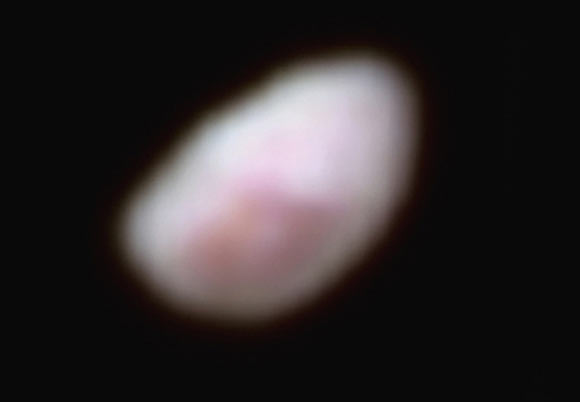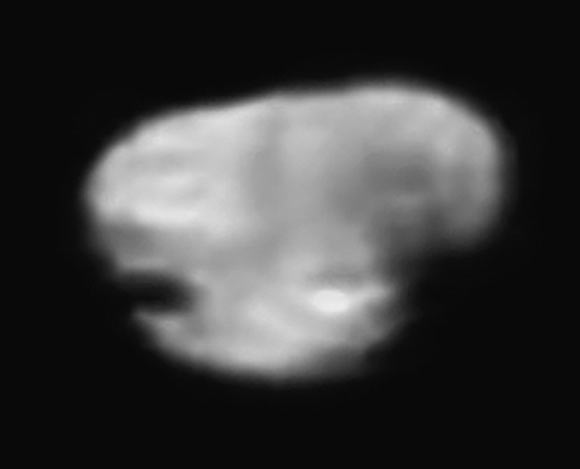NASA’s New Horizons spacecraft has captured the sharpest pictures yet of Pluto’s small satellites Nix and Hydra.

Nix, shown here in enhanced color as imaged by the Ralph instrument aboard New Horizons, has a reddish spot. The picture was snapped at a distance of 102,000 miles (165,000 km). It shows features as small as 2 miles (3 km) across. The data were obtained on the morning of July 14 and received on the ground on July 18. Image credit: NASA / Johns Hopkins University Applied Physics Laboratory / Southwest Research Institute.
Nix and Hydra were discovered in May 2005 by a team of scientists – led by New Horizons mission scientists Drs Alan Stern and Hal Weaver – using the Advanced Camera for Surveys on the NASA/ESA Hubble Space Telescope.
These icy moons are around 5,000 times fainter than Pluto, as seen from Earth, and are about two to three times farther from Pluto than its largest moon, Charon.
Nix and Hydra are approximately the same size, but their similarity ends there.
The new, color image of Nix reveals a mysterious region on the bean-shaped moon, which is estimated to be 26 miles (42 km) long and 22 miles (36 km) wide. Although the overall surface color of the small moon is neutral grey in the image, this region has a distinct red tint.
Hints of a bull’s-eye pattern lead New Horizons researchers to speculate that the reddish region is a crater.
“Additional compositional data has already been taken of Nix, but is not yet downlinked. It will tell us why this region is redder than its surroundings,” said Dr Carly Howett of Southwest Research Institute, a planetary scientist for the New Horizons mission.
“This observation is so tantalizing, I’m finding it hard to be patient for more Nix data to be downlinked,” she said.
Meanwhile, the new image of Hydra shows that its irregular shape resembles the state of Michigan.

This image of Hydra was taken by New Horizons’ LORRI instrument on July 14, 2015, from a distance of 143,000 miles (231,000 km). Image credit: NASA / Johns Hopkins University Applied Physics Laboratory / Southwest Research Institute.
New Horizons team members have estimated that the moon is 34 miles (55 km) long and 25 miles (40 km) wide.
“Before last week, Hydra was just a faint point of light, so it’s a surreal experience to see it become an actual place, as we see its shape and spot recognizable features on its surface for the first time,” Dr Ted Stryk of Roane State Community College in Tennessee, a New Horizons scientist.
The image was captured on July 14, 2015 from a distance of 143,000 miles (231,000 km). It shows features as small as 0.7 miles (1.2 km) across.
There appear to be at least two large craters, one of which is mostly in shadow.
The upper portion looks darker than the rest of the small moon, suggesting a possible difference in surface composition.







